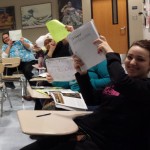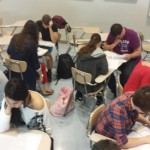Why Participation? Facilitating Student Engagement in Art History Surveys
On Thursday and Friday, February 12 and 13, 2015, as part of the poster session of the College Art Association conference, I will be presenting my project, “Tweets, Secret Words, Bingos, and Blogs: Facilitating Engaged Participation in Art History Surveys.” The following is an excerpt from that poster, presented here as a prompt for discussion amongst a broader audience. I hope we can collect here in the comments more ideas about how to actively engage our students to participate in art history courses. As the week comes to a close, I’ll post in these comments additional excerpts to share a few of my tricks.
(Image courtesy of The National Archives UK, via Flickr Commons.)
The spectacle – as a social relationship between people mediated by images – is pacifying and divisive, uniting us only through our separation from one another. (Bishop 2006, 12)
So many traditional art history survey classrooms function as venues for spectacular rather than participatory experiences: Students sit passively in immovable desks, staring at bright images on a screen that illuminates an otherwise dark classroom. The disembodied voice of their instructor tells (oftentimes quite compelling) stories about the projected images. The instructor is perpetually divided from the students by virtue of professorial authority, by controlling and narrating the images on the screen, by the implicit social contract established by the university setting. The professor remains the active and powerful agent who wields knowledge and grades while the students remain passive and receptive agents who receive all that is wielded at them.
To assemble people unprepared for an event and say that they are ‘participating’ if apples are thrown at them or they are herded about is to ask very little of the whole notion of participation. Most of the time the response of such an audience is half-hearted or even reluctant, and sometimes the reaction is vicious and therefore destructive to the work … in any case, ‘audience response’ proves to be so predictably pure cliché that anyone serious about the problem should not tolerate it, any more than the painter should continue the use of dripped paint as a stamp of modernity when it has been adopted by every lampshade and Formica manufacturer in the country. (Kaprow 1966, 103)
What applied to performance art, as Allan Kaprow noted in 1966, could equally well apply to teaching as performance. Half-hearted or reluctant participation of an audience of students can be extremely destructive to the work of learning. Like Kaprow, we should be asking much more of the whole notion of participation; our students should be performing their learning, not merely providing “audience response.”
Lectures, Long-term Learning, and the Illusion of Mastery
Simply listening to, or even reading, material (particularly material that is well presented and easy to comprehend) not only does not contribute to long-term learning, but in fact hinders learning by creating the illusion of mastery.
When [students] hear a lecture or read a text that is a paragon of clarity, the ease with which they follow the argument gives them the feeling that they already know it and don’t need to study it. In other words, they tend not to know what they don’t know; when put to the test, they find they cannot recall the critical ideas or apply them in a new context. Likewise, when they’ve reread their lecture notes and texts to the point of fluency, their fluency gives them the false sense that they’re in possession of the underlying content, principles, and implications that constitute real learning, confident that they can recall them at a moment’s notice. (Brown et al. 2014, 17)
In other words, when students think they know material (a state of being often fostered by eloquent lectures with little to no participation beyond note taking required), they are less likely to review and rehearse the material. They understood it in class, and they understand their notes (and might even be able to quote verbatim from them), therefore they believe they have mastered the concepts. However, if asked to give an impromptu, 30-second summary of the historical roots of the Italian Renaissance, or to identify the artist of an unknown work of art, they often find that they fall short. Their perception that they know the material prevents them from actually knowing or being able to use it.

A few of my students having fun participating using the day’s “Secret Word”: Orthogonal!
On the other hand, engaged participatory strategies ask students to self-test what they have learned, grapple with material in creative ways, and apply their learning to complex problems. This creates longer-lasting learning that can be accessed and employed again and again over time, rather than merely rehearsed for an exam and quickly forgotten. Active participation cultivates critical thinking, taking students past the level of repetition and into the actual doing of art history within the classroom itself.
Peer Review “Speed Dating” engages students in active participation.
How do you facilitate engaged participation in and beyond your art history classrooms?
Continue the conversation in the comments below and on twitter at #EngagedArtHistory.
References
Bishop, Claire. “Introduction / Viewers as Producers.” Participation: Documents of Contemporary Art. Cambridge, MA: MIT Press, 2006: 10-17.
Brown, Peter, Henry Roediger, and Mark McDaniel. Make It Stick: The Science of Successful Learning. Cambridge, MA: Harvard University Press, 2014.
Kaprow, Allan. “Notes on the Elimination of the Audience.” Participation: Documents of Contemporary Art. Cambridge, MA: MIT Press, 2006: 102-4.
Marie Gasper-Hulvat is an Assistant Professor of Art History at Kent State University at Stark. She has previously taught at The College of New Jersey, East Stroudsburg University, and the Maryland Institute College of Art.


The full poster can be found here: https://www.academia.edu/10801151/Tweets_Secret_Words_Bingos_and_Blogs_Facilitating_Engaged_Participation_in_Art_History_Surveys